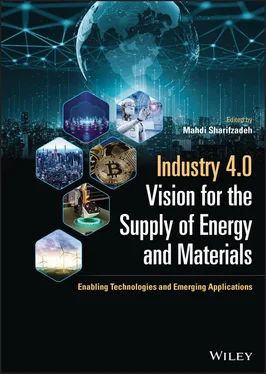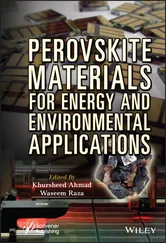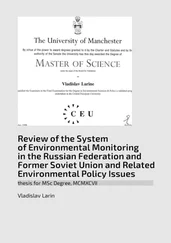Industry 4.0 Vision for the Supply of Energy and Materials
Здесь есть возможность читать онлайн «Industry 4.0 Vision for the Supply of Energy and Materials» — ознакомительный отрывок электронной книги совершенно бесплатно, а после прочтения отрывка купить полную версию. В некоторых случаях можно слушать аудио, скачать через торрент в формате fb2 и присутствует краткое содержание. Жанр: unrecognised, на английском языке. Описание произведения, (предисловие) а так же отзывы посетителей доступны на портале библиотеки ЛибКат.
- Название:Industry 4.0 Vision for the Supply of Energy and Materials
- Автор:
- Жанр:
- Год:неизвестен
- ISBN:нет данных
- Рейтинг книги:4 / 5. Голосов: 1
-
Избранное:Добавить в избранное
- Отзывы:
-
Ваша оценка:
- 80
- 1
- 2
- 3
- 4
- 5
Industry 4.0 Vision for the Supply of Energy and Materials: краткое содержание, описание и аннотация
Предлагаем к чтению аннотацию, описание, краткое содержание или предисловие (зависит от того, что написал сам автор книги «Industry 4.0 Vision for the Supply of Energy and Materials»). Если вы не нашли необходимую информацию о книге — напишите в комментариях, мы постараемся отыскать её.
Explore the impact of Industry 4.0 technologies on the supply chain with this authoritative text written by a leader in his field Industry 4.0 Vision for the Supply of Energy and Materials,
Industry 4.0 Vision for the Supply of Energy and Materials
Industry 4.0 Vision for the Supply of Energy and Materials — читать онлайн ознакомительный отрывок
Ниже представлен текст книги, разбитый по страницам. Система сохранения места последней прочитанной страницы, позволяет с удобством читать онлайн бесплатно книгу «Industry 4.0 Vision for the Supply of Energy and Materials», без необходимости каждый раз заново искать на чём Вы остановились. Поставьте закладку, и сможете в любой момент перейти на страницу, на которой закончили чтение.
Интервал:
Закладка:
255 245
256 246
257 247
258 248
259 249
260 250
261 251
262 252
263 253
264 254
265 255
266 256
267 257
268 258
269 259
270 260
271 261
272 262
273 263
274 264
275 265
276 266
277 267
278 268
279 269
280 270
281 271
282 272
283 273
284 274
285 275
286 276
287 277
288 278
289 279
290 280
291 281
292 282
293 283
294 284
295 285
296 286
297 287
298 288
299 289
300 290
301 291
302 292
303 293
304 294
305 295
306 296
307 297
308 298
309 299
310 300
311 301
312 302
313 303
314 304
315 305
316 306
317 307
318 308
319 309
320 310
321 311
322 312
323 313
324 314
325 315
326 316
327 317
328 318
329 319
330 320
331 321
332 322
333 323
334 324
335 325
336 326
337 327
338 328
339 329
340 330
341 331
342 332
343 333
344 334
345 335
346 336
347 337
348 338
349 339
350 340
351 341
352 342
353 343
354 344
355 345
356 346
357 347
358 348
359 349
360 350
361 351
362 352
363 353
364 354
365 355
366 356
367 357
368 358
369 359
370 360
371 361
372 362
373 363
374 364
375 365
376 366
377 367
378 368
379 369
380 370
381 371
382 372
383 373
384 374
385 375
386 376
387 377
388 378
389 379
390 380
391 381
392 382
393 383
Preface
The Fourth Industrial Revolution, also known as Industry 4.0 or I4.0, refers to the recent accelerated uptake of a portfolio of technologies that enable a high degree of automation, integration, transparency, decentralization, and at the same time interconnectedness in the industrial sector, as well as other sectors such as health, education, and agriculture, enabling optimal and evidence-based decision-making. The emergence of Industry 4.0 is the result of dramatic advances and convergence in multiple disciplines. These include a sharp increase in the capabilities for artificial intelligence, wireless communication (e.g., Internet of things), cloud-based computations, smart transactions (blockchains), and robotics. Such capabilities have manifested themselves in the form of novel paradigms such as smart manufacturing, the Internet of things, predictive maintenance, and additive manufacturing.
The present contribution reports the collective endeavors of a multidisciplinary group of researchers to explore the emerging trends inspired by the aforementioned evolutions, especially with the focus on the flow of energy and materials in supply chains. The book has two main parts. In the first part, the key drivers of Industry 4.0, namely, artificial intelligence, wireless communication, blockchains and smart contracts, cloud computing, and robotics, are discussed. The second part explores the application of such advancements in the fields of energy networks, additive manufacturing, pharmaceutical industry, water distribution, renewable power generation, petroleum and gas industries, as discussed in the following.
Chapter 1 explores recent advancements in sensor and communication technologies and their contribution to the realization and commercial viability of industrial/Internet of things (I/IoTs), smart manufacturing, and other Industry 4.0 paradigms. It also discusses the applications of communication technologies in Industry 4.0 and the required criteria. Other features of interest include the relevant standards and protocols, cellular and mobile technologies, the design of wireless systems for IIoT applications and relevant protocols, and smart sensors and their enabling role in Industry 4.0. The chapter concludes with predicting future trends in wireless communication for Industry 4.0.
Chapter 2 explores the concepts and methods that have enabled distributed and smart transaction systems such as blockchains. The features of interest include the blockchain taxonomy, desirable attributes, architecture, and most importantly the emerging applications in different sectors.
Chapter 3 is concerned with the application of robotics in Industry 4.0. First, a comprehensive survey of various classes of robots is presented. The classification is presented with respect to robots’ geometry, actuator and control strategies, and kinematics, as well as more advanced features such as the number of agents and fabrication materials. Then the applications of various robotic systems are presented in different areas.
Chapter 4 focuses on the utilization of cloud computing in Industry 4.0. The main characteristics of cloud computing, as well as developed architectures and types of services, the model of cloud deployment, and the corresponding pros and cons are extensively discussed in this chapter. The last part of this chapter explores emerging paradigms such as edge computing and fog computing and elucidate their differences compared with traditional cloud and grid computing.
Chapter 5 provides a comprehensive review of artificial intelligence (AI) methods. The reviewed algorithms are categorized into supervised and unsupervised methods. In the supervised methods, two major groups of classification and regression methods are discussed. In the classification methods, the key features of decision trees (DT), the (naive) Bayesian classifier, K-nearest neighbors (KNNs), linear discriminant analysis (LDA), support vector machines (SVM) and kernel methods, relevance vector machines (RVMs), ensemble methods, and logistic regression are reviewed. In the regression methods, ordinary least squares (OLS) regression, ridge and lasso regression, support vector regression (SVR), Gaussian process regression (GPR), and thin plate spline (TPS) are discussed. A separate section is devoted to neural networks and deep learning, especially to recent developments in convolutional neural networks (CNNs), recurrent neural networks (RNNs), long short-term memory (LSTM), transformers, graph neural networks (GNNs), generative adversarial networks (GAN), autoencoders, and self-organizing maps (SOMs). Among unsupervised learning algorithms, special attention is paid to clustering methods such as k-means clustering and hierarchical clustering, DBSCAN, as well as linear and nonlinear dimensionality reduction methods (e.g., principal component analysis [PCA], linear discriminant analysis, manifold learning, Laplacian eigenmaps method). This chapter also provides a brief overview of semi-supervised and active Learning, bio-inspired methods, as well as reinforcement learning (RL).
The second part of the book begins with Chapter 6, in which the concept of the Internet of energy (IoE) is introduced. The discussion starts with the description of conventional energy grids, exposure of their limitations, and elucidation of the potentials that have become available through the incorporation of the Industry 4.0 technologies. It continues by reviewing the structure of IoE, with particular emphasis on energy routers, energy hubs, and software-defined networks (SDNs). The utilization of other I4.0 technologies such as big-data analytics and blockchains are also discussed with a special focus on energy trading and transactive IoE.
In Chapter 7, a more specific problem relevant to the Internet of energy is evaluated, which is concerned with the evolving nature of energy infrastructures. Considering the depleting fossil sources and their negative environmental impact, significant efforts are devoted to commercial utilization of renewable energies such as wind and solar power generation. However, the high penetration of renewable energies in the electricity grid also poses a significant challenge due to the intermittent and stochastic nature of wind and solar energies. The conventional approach to tackle such complexity is either through costly energy storage or provision of standby power plant capacity that is usually driven by fossil fuels. However, a paradigm shift has emerged using advanced control and communication systems that would deploy predictive analytics for real-time optimization, eliminating the need for expensive solutions such as energy storage and power plant extra capacity. The chapter explores the economic benefits of utilizing such intelligent systems, through the integration of artificial intelligence in the form time-series prediction, and optimization programming for electricity expansion planning and real-time dispatch.
Читать дальшеИнтервал:
Закладка:
Похожие книги на «Industry 4.0 Vision for the Supply of Energy and Materials»
Представляем Вашему вниманию похожие книги на «Industry 4.0 Vision for the Supply of Energy and Materials» списком для выбора. Мы отобрали схожую по названию и смыслу литературу в надежде предоставить читателям больше вариантов отыскать новые, интересные, ещё непрочитанные произведения.
Обсуждение, отзывы о книге «Industry 4.0 Vision for the Supply of Energy and Materials» и просто собственные мнения читателей. Оставьте ваши комментарии, напишите, что Вы думаете о произведении, его смысле или главных героях. Укажите что конкретно понравилось, а что нет, и почему Вы так считаете.












